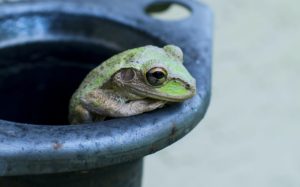
I love reading stories like this one. Researchers were interested in a specific type of frog that lives near waterfalls. They were curious because most frogs of this particular type are found away from waterfalls. And because they are away from waterfalls and the subsequent white noise, they are able to use vocal mating calls like many other frogs.
But the frogs near the waterfall had to adapt. They still used vocal calling, but they used a much higher pitch that would cut through the background noise. And they would also wave their arms and legs and do different kinds of movements to communicate with other frogs.
If you spend any time in nature you start to see that wild animals are incredible at this type of thing. And it’s not just similar animals living in different surroundings. It’s the same animal adapting to new surroundings that are changing around them.
I live in Wisconsin and one of the amazing animals that lives in this state is the whitetail deer. I spend a lot of time in the woods each year watching them. And I also see them around my home all the time. The one thing that is constant in their environment is that the surroundings are changing. Trees get bigger. Things get mowed. Trees are cut and replanted. New growth overtakes old fields and meadows. Crops are changed. It’s really incredible the amount of change that can occur in a whitetail’s world during their lifetime.
But they’re always able to adapt. Well, not always, but may are able to adapt either through luck or skill or whatever the case. They are able to adapt and thrive no matter what changes.
And that’s not easy because these animals are incredibly habitual. They have certain routines that they do over and over. They like to find their safe routines and stick with it until the status quo changes. And when it changes they recognize it and adapt.
For example, a buck may have a little hiding spot deep in the woods. But a new hunter comes into the woods and starts hunting that buck right in its core area. The bucks stays for awhile, perhaps using an escape route or two when the hunter moves in. Then eventually the buck realizes that the area isn’t safe anymore and moves to a new area.
I’ve also seen does that have a great spot for having their fawns. Usually these are large, tall grassy areas where the fawn can be safe from predators. But sometimes these grassy spots are mowed, burned, or become overgrown with trees. This forces the doe to find a new spot for future fawns.
Animals are incredible at finding the good in their surroundings. They assess what the reality is and look for ways to survive and thrive.
And here’s a little secret…humans are no different. If we’re willing to adapt.
